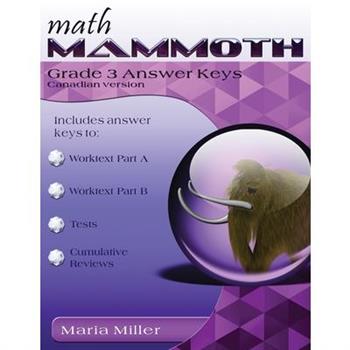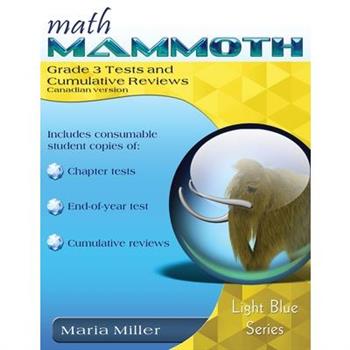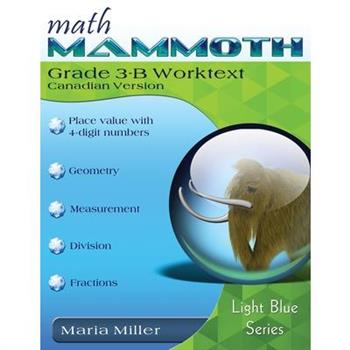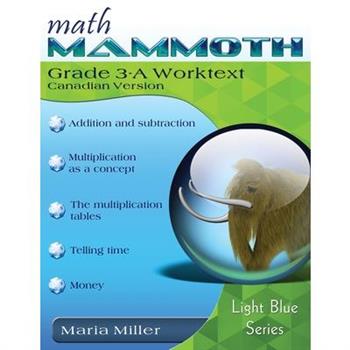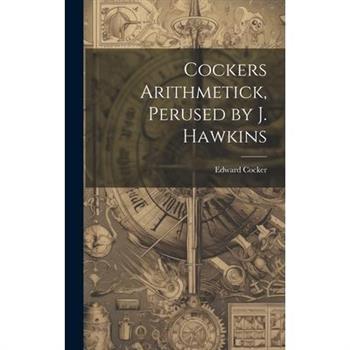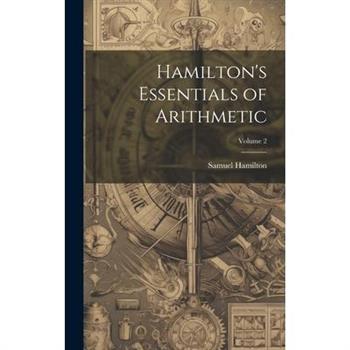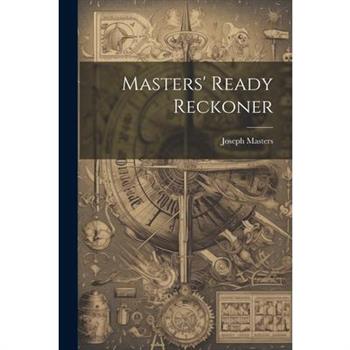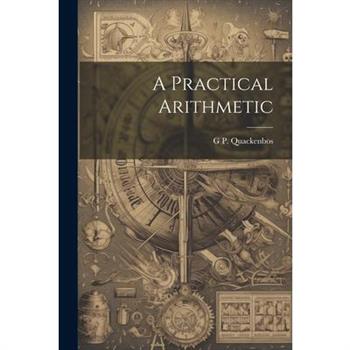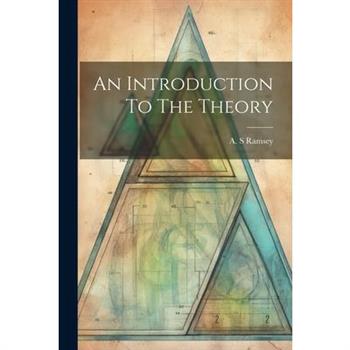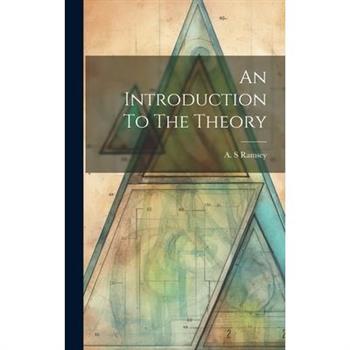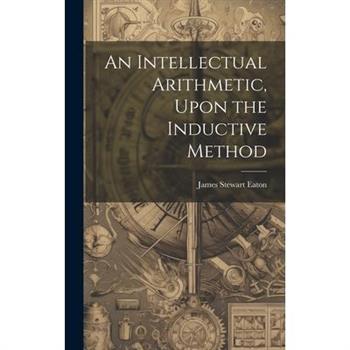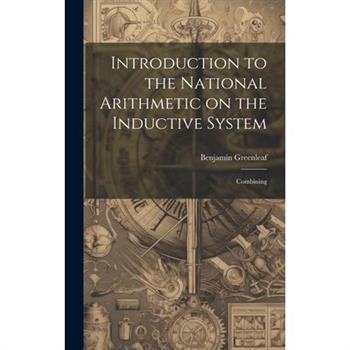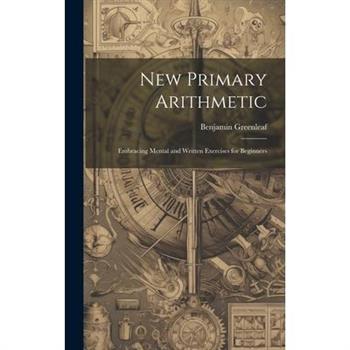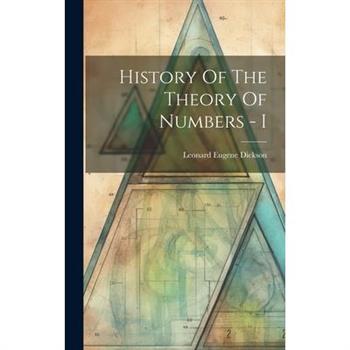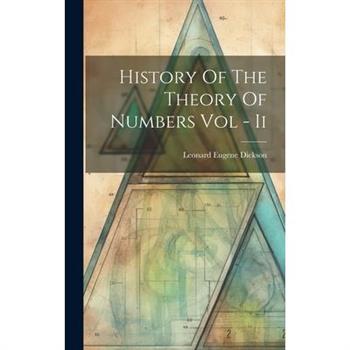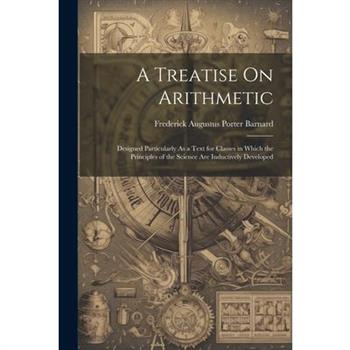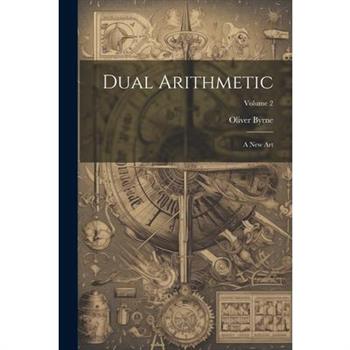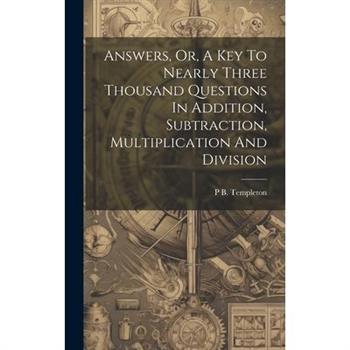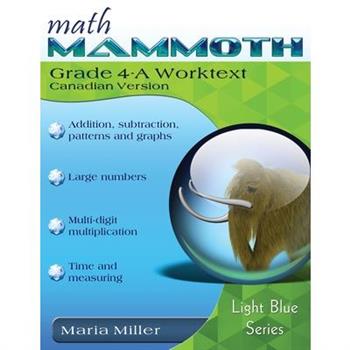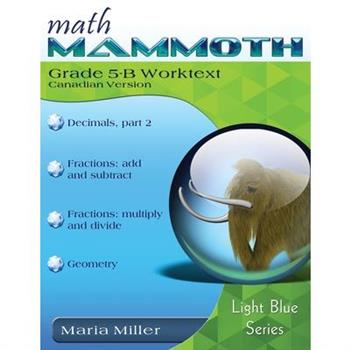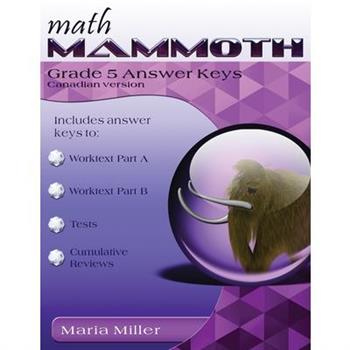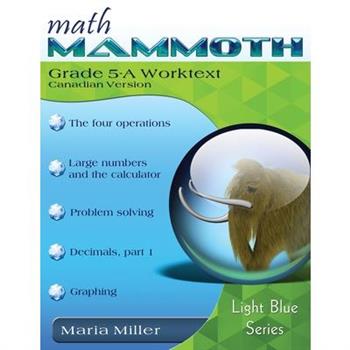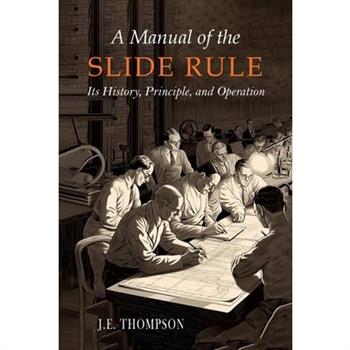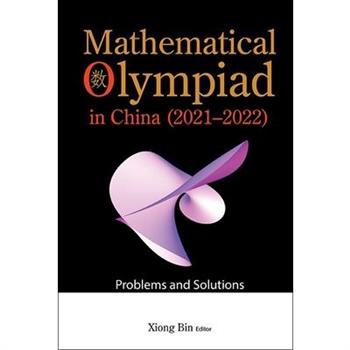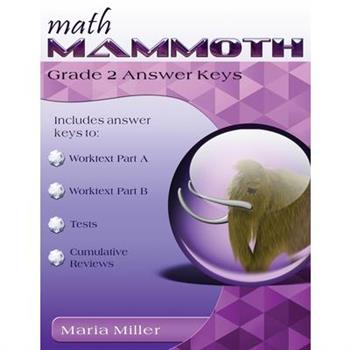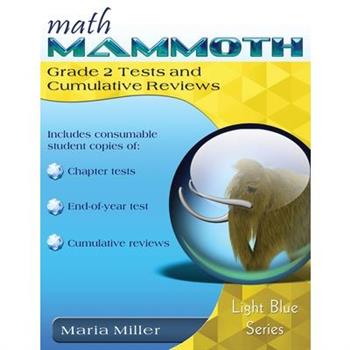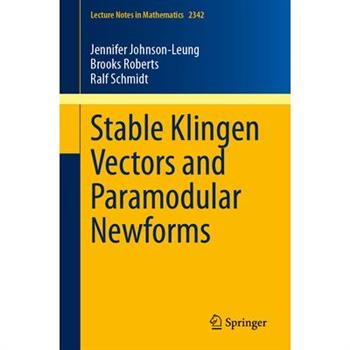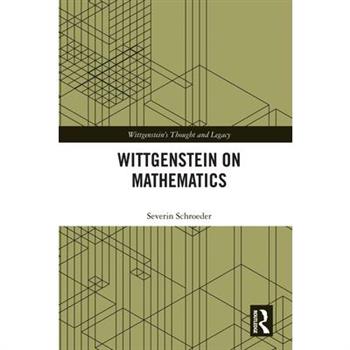Math Mammoth Grade 3 Answer Keys, Canadian Version
This book includes answers for Math Mammoth Grade 3-A and 3-B student worktexts (Canadian version), for all of the chapter tests, and for the cumulative reviews. The other parts of the curriculum may be purchased separately at Lulu.
Math Mammoth Grade 3 Tests and Cumulative Reviews, Canadian Version
Math Mammoth Grade 3 Tests and Cumulative Reviews (Canadian Version) contains the chapter tests, end-of-year test, and cumulative revision worksheets for Math Mammoth grade 3 curriculum. It does not contain answers; the answer key book may be purchased separately.
Math Mammoth Grade 3-B Worktext, Canadian Version
Math Mammoth Grade 3-B Worktext (Canadian version) is the student book for the second half of third grade math. In this part B, the main areas of study are: place value (4-digit numbers)the concept of division and basic division facts; geometry (area and perimeter); measurement; fractions. The curriculum is essentially the same as the U.S. version of Math Mammoth Grade 3, only customized for the Canadian audience in these aspects: The curriculum teaches the metric measurement units. Imperial units, such as inches and pounds, are not used.The spelling conforms mostly to American English, taking into account a few key differences where Canadian English follows British English.Numbers are formatted with a space as a thousands separator, and a point as a decimal separator.Page (paper) size is Letter.FeaturesMath Mammoth focuses on conceptual understanding. It explains the "WHY", so your children can understand the math, not just learn "HOW" to do it.Concepts are often explained with visual models, followed by exercises using those models. These visual models can take the place of manipulatives for many children; however, it is very easy to add corresponding manipulatives to the lessons if so desired.The curriculum is mastery-oriented. This means it concentrates fairly long on a topic, delving into its various aspects. This promotes conceptual understanding, as opposed to spiral curricula that often tend to jump from topic to topic too much.There is a strong emphasis on mental math and number sense.It requires very little teacher preparation, which is a big help to most parents. The curriculum has no separate teacher's manual nor is it scripted. The introduction to each chapter has some notes for the teacher concerning the material in the chapter. All the instruction is written directly to the student in the worktext, and there also exist accompanying videos where you can see Maria herself teach the material.After each chapter introduction, you will find a list of Internet links and resources (games, quizzes, animations, etc.) that can be used for fun, illustrations and further practice.For multiplication tables and division facts, you can use our online practice program (free).A companion to this book, Math Mammoth Grade 3-A worktext, covers the first half of 3rd grade math (available separately).
Math Mammoth Grade 3-A Worktext, Canadian Version
Math Mammoth Grade 3-A worktext (Light Blue Series) is the student book for the first half of third grade math. In this part A, the main areas of study are: addition and subtraction within 1,000 (including mental math); the concept of multiplication; the multiplication tables; telling time and working with time intervals; counting coins and solving problems related to money.FeaturesMath Mammoth focuses on conceptual understanding. It explains the "WHY", so your children can understand the math, not just learn "HOW" to do it.Concepts are often explained with visual models, followed by exercises using those models. These visual models can take the place of manipulatives for many children; however, it is very easy to add corresponding manipulatives to the lessons if so desired.The curriculum is mastery-oriented. This means it concentrates fairly long on a topic, delving into its various aspects. This promotes conceptual understanding, as opposed to spiral curricula that often tend to jump from topic to topic too much.There is a strong emphasis on mental math and number sense.It requires very little teacher preparation, which is a big help to most parents. The curriculum has no separate teacher's manual nor is it scripted. The introduction to each chapter has some notes for the teacher concerning the material in the chapter. All the instruction is written directly to the student in the worktext, and there also exist accompanying videos where you can see Maria herself teach the material.After each chapter introduction, you will find a list of Internet links and resources (games, quizzes, animations, etc.) that can be used for fun, illustrations and further practice.For multiplication tables and division facts, you can use our online practice program (free).This curriculum is essentially the same as the U.S. version of Math Mammoth Grade 3, only customized for the Canadian audience in these aspects: The curriculum teaches the metric measurement units. Imperial units, such as inches and pounds, are not used.The spelling conforms mostly to American English, taking into account a few key differences where Canadian English follows British English.Numbers are formatted with a space as a thousands separator, and a point as a decimal separator.The currency used in the chapter on money is the Canadian dollar.Page (paper) size is Letter.
A Practical Arithmetic
A Practical Arithmetic is an unchanged, high-quality reprint of the original edition of 1873. Hansebooks is editor of the literature on different topic areas such as research and science, travel and expeditions, cooking and nutrition, medicine, and other genres. As a publisher we focus on the preservation of historical literature. Many works of historical writers and scientists are available today as antiques only. Hansebooks newly publishes these books and contributes to the preservation of literature which has become rare and historical knowledge for the future.
Complete Arithmetic, Part II
An essential guide to arithmetic for students and teachers alike. This book covers topics such as fractions, decimals, and advanced algebra, making it an ideal resource for anyone looking to develop their mathematical skills.This work has been selected by scholars as being culturally important, and is part of the knowledge base of civilization as we know it.This work is in the "public domain in the United States of America, and possibly other nations. Within the United States, you may freely copy and distribute this work, as no entity (individual or corporate) has a copyright on the body of the work.Scholars believe, and we concur, that this work is important enough to be preserved, reproduced, and made generally available to the public. We appreciate your support of the preservation process, and thank you for being an important part of keeping this knowledge alive and relevant.
Cockers Arithmetick, Perused by J. Hawkins
First published in 1678, Edward Cocker's Arithmetick is a classic text that has been used for centuries to teach the principles of mathematics. This edition, perused by J Hawkins, includes helpful explanations and examples that make even the most complex concepts easy to grasp. Whether you're a student, a teacher, or just someone who loves numbers, this book is sure to become a favorite.This work has been selected by scholars as being culturally important, and is part of the knowledge base of civilization as we know it.This work is in the "public domain in the United States of America, and possibly other nations. Within the United States, you may freely copy and distribute this work, as no entity (individual or corporate) has a copyright on the body of the work.Scholars believe, and we concur, that this work is important enough to be preserved, reproduced, and made generally available to the public. We appreciate your support of the preservation process, and thank you for being an important part of keeping this knowledge alive and relevant.
Hamilton's Essentials of Arithmetic; Volume 2
Hamilton's Essentials of Arithmetic is an indispensable guide to the fundamental principles of mathematics. Written by Samuel Hamilton, an experienced teacher and mathematician, this book covers all the essential topics in arithmetic, from basic operations and fractions to percentages, algebra and geometry. With clear explanations and worked examples, as well as a wide range of practice exercises and quizzes, Hamilton's Essentials of Arithmetic is an ideal textbook for students of all ages and abilities.This work has been selected by scholars as being culturally important, and is part of the knowledge base of civilization as we know it.This work is in the "public domain in the United States of America, and possibly other nations. Within the United States, you may freely copy and distribute this work, as no entity (individual or corporate) has a copyright on the body of the work.Scholars believe, and we concur, that this work is important enough to be preserved, reproduced, and made generally available to the public. We appreciate your support of the preservation process, and thank you for being an important part of keeping this knowledge alive and relevant.
Masters' Ready Reckoner
This practical book is a comprehensive guide to everyday arithmetic. It includes information on measurements, weights and measures, and other important calculations. It is an excellent resource for students, professionals, and anyone else who needs to perform quick calculations on a regular basis.This work has been selected by scholars as being culturally important, and is part of the knowledge base of civilization as we know it.This work is in the "public domain in the United States of America, and possibly other nations. Within the United States, you may freely copy and distribute this work, as no entity (individual or corporate) has a copyright on the body of the work.Scholars believe, and we concur, that this work is important enough to be preserved, reproduced, and made generally available to the public. We appreciate your support of the preservation process, and thank you for being an important part of keeping this knowledge alive and relevant.
A Practical Arithmetic
First published in the mid-19th century, this classic textbook teaches arithmetic through a series of practical and relevant problems, such as measuring land, calculating interest, and making change. With clear explanations and plenty of practice exercises, this book is perfect for anyone looking to improve their numeracy skills.This work has been selected by scholars as being culturally important, and is part of the knowledge base of civilization as we know it.This work is in the "public domain in the United States of America, and possibly other nations. Within the United States, you may freely copy and distribute this work, as no entity (individual or corporate) has a copyright on the body of the work.Scholars believe, and we concur, that this work is important enough to be preserved, reproduced, and made generally available to the public. We appreciate your support of the preservation process, and thank you for being an important part of keeping this knowledge alive and relevant.
An Introduction To The Theory
This classic introduction to the theory of numbers provides a clear and accessible guide to the fundamental concepts and techniques of number theory. Ramsey's elegant exposition covers everything from prime numbers and diophantine equations to modular forms and zeta functions, making this an essential text for anyone interested in this fascinating field. With exercises and solutions included at the end of each chapter, this book is ideal for self-study or as a text for an undergraduate course in number theory.This work has been selected by scholars as being culturally important, and is part of the knowledge base of civilization as we know it.This work is in the "public domain in the United States of America, and possibly other nations. Within the United States, you may freely copy and distribute this work, as no entity (individual or corporate) has a copyright on the body of the work.Scholars believe, and we concur, that this work is important enough to be preserved, reproduced, and made generally available to the public. We appreciate your support of the preservation process, and thank you for being an important part of keeping this knowledge alive and relevant.
An Introduction To The Theory
This classic introduction to the theory of numbers provides a clear and accessible guide to the fundamental concepts and techniques of number theory. Ramsey's elegant exposition covers everything from prime numbers and diophantine equations to modular forms and zeta functions, making this an essential text for anyone interested in this fascinating field. With exercises and solutions included at the end of each chapter, this book is ideal for self-study or as a text for an undergraduate course in number theory.This work has been selected by scholars as being culturally important, and is part of the knowledge base of civilization as we know it.This work is in the "public domain in the United States of America, and possibly other nations. Within the United States, you may freely copy and distribute this work, as no entity (individual or corporate) has a copyright on the body of the work.Scholars believe, and we concur, that this work is important enough to be preserved, reproduced, and made generally available to the public. We appreciate your support of the preservation process, and thank you for being an important part of keeping this knowledge alive and relevant.
An Intellectual Arithmetic, Upon the Inductive Method
This book provides a comprehensive and detailed study of arithmetic, with a focus on the inductive method of reasoning. The author provides insightful commentary and analysis in a highly readable style. A must-read for educators and mathematicians.This work has been selected by scholars as being culturally important, and is part of the knowledge base of civilization as we know it.This work is in the "public domain in the United States of America, and possibly other nations. Within the United States, you may freely copy and distribute this work, as no entity (individual or corporate) has a copyright on the body of the work.Scholars believe, and we concur, that this work is important enough to be preserved, reproduced, and made generally available to the public. We appreciate your support of the preservation process, and thank you for being an important part of keeping this knowledge alive and relevant.
Introduction to the National Arithmetic on the Inductive System
This classic mathematics textbook covers arithmetic using the inductive system, written by Benjamin Greenleaf who was a prominent American educator and mathematician. Through accessible language and carefully crafted examples, Greenleaf introduces important concepts in arithmetic, making this book an essential resource for students and teachers alike.This work has been selected by scholars as being culturally important, and is part of the knowledge base of civilization as we know it.This work is in the "public domain in the United States of America, and possibly other nations. Within the United States, you may freely copy and distribute this work, as no entity (individual or corporate) has a copyright on the body of the work.Scholars believe, and we concur, that this work is important enough to be preserved, reproduced, and made generally available to the public. We appreciate your support of the preservation process, and thank you for being an important part of keeping this knowledge alive and relevant.
New Primary Arithmetic
A timeless classic, this book offers a comprehensive overview of basic arithmetic skills that are still relevant today. With a focus on mental math and problem solving, it's the perfect resource for anyone looking to improve their math skills.This work has been selected by scholars as being culturally important, and is part of the knowledge base of civilization as we know it.This work is in the "public domain in the United States of America, and possibly other nations. Within the United States, you may freely copy and distribute this work, as no entity (individual or corporate) has a copyright on the body of the work.Scholars believe, and we concur, that this work is important enough to be preserved, reproduced, and made generally available to the public. We appreciate your support of the preservation process, and thank you for being an important part of keeping this knowledge alive and relevant.
History Of The Theory Of Numbers - I
A landmark work in the field of mathematics, History of the Theory of Numbers - I traces the development of number theory from ancient civilizations to the early 20th century. Written by mathematician Leonard Eugene Dickson, this book is a comprehensive and accessible introduction to the history of one of the most fundamental branches of mathematics.This work has been selected by scholars as being culturally important, and is part of the knowledge base of civilization as we know it.This work is in the "public domain in the United States of America, and possibly other nations. Within the United States, you may freely copy and distribute this work, as no entity (individual or corporate) has a copyright on the body of the work.Scholars believe, and we concur, that this work is important enough to be preserved, reproduced, and made generally available to the public. We appreciate your support of the preservation process, and thank you for being an important part of keeping this knowledge alive and relevant.
History Of The Theory Of Numbers Vol - Ii
This comprehensive work provides a detailed history of number theory, from its origins in ancient Greece to the modern day. The author goes beyond mere exposition, giving readers a deep understanding of the underlying concepts and theorems. This book is essential reading for anyone interested in the fascinating world of number theory.This work has been selected by scholars as being culturally important, and is part of the knowledge base of civilization as we know it.This work is in the "public domain in the United States of America, and possibly other nations. Within the United States, you may freely copy and distribute this work, as no entity (individual or corporate) has a copyright on the body of the work.Scholars believe, and we concur, that this work is important enough to be preserved, reproduced, and made generally available to the public. We appreciate your support of the preservation process, and thank you for being an important part of keeping this knowledge alive and relevant.
History Of The Theory Of Numbers - I
A landmark work in the field of mathematics, History of the Theory of Numbers - I traces the development of number theory from ancient civilizations to the early 20th century. Written by mathematician Leonard Eugene Dickson, this book is a comprehensive and accessible introduction to the history of one of the most fundamental branches of mathematics.This work has been selected by scholars as being culturally important, and is part of the knowledge base of civilization as we know it.This work is in the "public domain in the United States of America, and possibly other nations. Within the United States, you may freely copy and distribute this work, as no entity (individual or corporate) has a copyright on the body of the work.Scholars believe, and we concur, that this work is important enough to be preserved, reproduced, and made generally available to the public. We appreciate your support of the preservation process, and thank you for being an important part of keeping this knowledge alive and relevant.
History Of The Theory Of Numbers Vol - Ii
This comprehensive work provides a detailed history of number theory, from its origins in ancient Greece to the modern day. The author goes beyond mere exposition, giving readers a deep understanding of the underlying concepts and theorems. This book is essential reading for anyone interested in the fascinating world of number theory.This work has been selected by scholars as being culturally important, and is part of the knowledge base of civilization as we know it.This work is in the "public domain in the United States of America, and possibly other nations. Within the United States, you may freely copy and distribute this work, as no entity (individual or corporate) has a copyright on the body of the work.Scholars believe, and we concur, that this work is important enough to be preserved, reproduced, and made generally available to the public. We appreciate your support of the preservation process, and thank you for being an important part of keeping this knowledge alive and relevant.
Introduction to the Tools of Scientific Computing
The book provides an introduction to common programming tools and methods in numerical mathematics and scientific computing. Unlike standard approaches, it does not focus on any specific language, but aims to explain the underlying ideas.Typically, new concepts are first introduced in the particularly user-friendly Python language and then transferred and extended in various programming environments from C/C++, Julia and MATLAB to Maple and Mathematica. This includes various approaches to distributed computing. By examining and comparing different languages, the book is also helpful for mathematicians and practitioners in deciding which programming language to use for which purposes.At a more advanced level, special tools for the automated solution of partial differential equations using the finite element method are discussed. On a more experimental level, the basic methods of scientific machine learning in artificial neural networks are explained and illustrated.
A Treatise On Arithmetic
Barnard's work provides a systematic introduction to the principles of arithmetic, with a focus on developing a deep understanding of the underlying concepts. Filled with examples and exercises, this book is an essential resource for math students and teachers alike.This work has been selected by scholars as being culturally important, and is part of the knowledge base of civilization as we know it.This work is in the "public domain in the United States of America, and possibly other nations. Within the United States, you may freely copy and distribute this work, as no entity (individual or corporate) has a copyright on the body of the work.Scholars believe, and we concur, that this work is important enough to be preserved, reproduced, and made generally available to the public. We appreciate your support of the preservation process, and thank you for being an important part of keeping this knowledge alive and relevant.
Dual Arithmetic
This book offers a unique approach to arithmetic, using geometric shapes and colors to represent numbers and operations. It includes numerous examples and exercises to help readers master this innovative method. The publication provides a fascinating glimpse into the history and diversity of mathematical pedagogy. This work has been selected by scholars as being culturally important, and is part of the knowledge base of civilization as we know it.This work is in the "public domain in the United States of America, and possibly other nations. Within the United States, you may freely copy and distribute this work, as no entity (individual or corporate) has a copyright on the body of the work.Scholars believe, and we concur, that this work is important enough to be preserved, reproduced, and made generally available to the public. We appreciate your support of the preservation process, and thank you for being an important part of keeping this knowledge alive and relevant.
Answers, Or, A Key To Nearly Three Thousand Questions In Addition, Subtraction, Multiplication And Division
This handy reference book provides easy-to-use answers to a wide range of mathematical questions. P. B. Templeton provides a comprehensive guide to arithmetic operations, with step-by-step solutions to common problems in addition, subtraction, multiplication, and division. This book is a must-have resource for students and teachers, and is suitable for all levels of mathematical ability.This work has been selected by scholars as being culturally important, and is part of the knowledge base of civilization as we know it.This work is in the "public domain in the United States of America, and possibly other nations. Within the United States, you may freely copy and distribute this work, as no entity (individual or corporate) has a copyright on the body of the work.Scholars believe, and we concur, that this work is important enough to be preserved, reproduced, and made generally available to the public. We appreciate your support of the preservation process, and thank you for being an important part of keeping this knowledge alive and relevant.
Math Mammoth Grade 4 Answer Keys, Canadian Version
This book includes answers for the Math Mammoth Grade 4-A and 4-B student worktexts (Canadian version), for all the chapter tests, for the end-of-year test, and for the cumulative review lessons in Math Mammoth Grade 4 curriculum (Canadian version).
Math Mammoth Grade 4 Tests and Cumulative Reviews, Canadian Version
Math Mammoth Grade 4 Tests and Cumulative Revisions (Canadian version) contains the end-of-chapter tests, end-of-year test, and cumulative review lessons for Math Mammoth grade 4 curriculum. Note: this book does not contain answers. The answer key book for grade 4 may be purchased separately.
Math Mammoth Grade 4-B Worktext, Canadian Version
Math Mammoth Grade 4-B worktext (Canadian version) is the student worktext for the latter half of the 4th grade math, and part of Math Mammoth complete curriculum for fourth grade. The book starts out with the topic of division. The focus is on learning long division and using division in word problems.In the geometry chapter, students first revise area and perimeter, and then concentrate on the topic of angles. Students measure and draw angles, solve simple angle problems and classify triangles according to their angles. They also study parallel and perpendicular lines.Fractions and decimals are presented last in the school year. These two chapters practise only some of the basic operations with fractions and decimals. The focus is still on conceptual understanding and on building a good foundation towards 5th grade math, where fractions and decimals will be in focus. FeaturesMath Mammoth focuses on conceptual understanding. It explains the "WHY", so your children can understand the math, not just learn "HOW" to do it.The curriculum is mastery-oriented. This means it concentrates fairly long on a topic, delving into its various aspects. This promotes conceptual understanding, as opposed to spiral curricula that often tend to jump from topic to topic too much.There is a strong emphasis on mental math and number sense.It requires very little teacher preparation, which is a big help to most parents.: ) The curriculum has no separate teacher's manual nor is it scripted. The introduction to each chapter has some notes for the teacher concerning the material in the chapter. All the instruction is written directly to the student.
Math Mammoth Grade 4-A Worktext, Canadian Version
Math Mammoth Grade 4-A worktext (Canadian version) is the student worktext for the first half of the 4th grade math, and part of Math Mammoth complete curriculum for fourth grade. This book starts out with a review of addition and subtraction, patterns, and graphs. We illustrate word problems with bar diagrams and study finding missing addends, which teaches algebraic thinking. Children also learn addition and subtraction terminology, the order of operations, and statistical graphs.Next come large numbers-up to millions, and the place value concept. At first the student reviews thousands and some mental math with them. Next are presented numbers up to one million, calculations with them, the concept of place value and comparing. In the end of the chapter we find out more about millions and an introduction to multiples of 10, 100, and 1000. The third chapter is all about multiplication. After briefly reviewing the concept and the times tables, the focus is on learning multi-digit multiplication (multiplication algorithm). The children also learn why it works when they multiply in parts. We also study the order of operations again, touch on proportional reasoning, and do more money and change related word problems.The last chapter in the 4-A worktext is about time, temperature, length, weight, and volume. Students will learn to solve more complex problems using various measuring units and to convert between measuring units. FeaturesMath Mammoth focuses on conceptual understanding. It explains the "WHY", so your children can understand the math, not just learn "HOW" to do it.The curriculum is mastery-oriented. This means it concentrates fairly long on a topic, delving into its various aspects. This promotes conceptual understanding, as opposed to spiral curricula that often tend to jump from topic to topic too much.There is a strong emphasis on mental math and number sense.It requires very little teacher preparation, which is a big help to most parents.: )The curriculum has no separate teacher's manual nor is it scripted. The introduction to each chapter has some notes for the teacher concerning the material in the chapter. All the instruction is written directly to the student.
Math Mammoth Grade 5-B Worktext, Canadian Version
Math Mammoth Grade 5-B Worktext is the student book for the second half of grade 5, and part of the Math Mammoth Grade 5 complete curriculum. This is the Canadian version, which means the book uses mostly metric units, is formatted to letter size, and large numbers are formatted with a space (e.g. 214 000). However, keep in mind that the "Grade 5" refers to the U.S. grade 5, and corresponds roughly to Canadian school system's year 6. The main areas of study in this Grade 5-B worktext are operations with decimals, fraction arithmetic (all operations with fractions), and geometry (review of angles, area, and perimeter; drawing circles; classifying triangles & quadrilaterals; volume of rectangular prisms). In chapter 5 we study graphing in the coordinate grid, line graphs, and average. Today's world has become increasingly complex with lots of data presented in the media, so our children need a good grasp of statistical graphs to be able to make sense of all of that information. Chapter 6 continues our study of decimals. The focus is on multiplying decimals by decimals, dividing decimals by decimals and conversions between measuring units. Chapter 7 covers the addition and subtraction of fractions - another topic of focus for 5th grade, besides decimals. The most difficult topic of this chapter is adding and subtracting unlike fractions, which is done by first converting them to equivalent fractions with a common denominator. In chapter 8, we study the multiplication and division of fractions from various angles. Chapter 9 takes us to geometry, starting with a review of angles and polygons. From there, students will learn to draw circles, to classify triangles and quadrilaterals, and the concept of volume in the context of right rectangular prisms (boxes). Please note this is the student worktext and does not contain the answers. The answer key book is available separately.
Math Mammoth Grade 5 Tests and Cumulative Reviews, Canadian Version
Math Mammoth Grade 5 Tests and Cumulative Reviews (Canadian Version ) contains the chapter tests, end-of-year test, and cumulative review worksheets for Math Mammoth grade 5 curriculum. It does not contain answers; the answer key book may be purchased separately.
Math Mammoth Grade 5 Answer Keys, Canadian Version
This book includes answers for Math Mammoth Grade 5-A and 5-B student worktexts (Canadian version), for all of the chapter tests, and for the cumulative reviews. The other parts of the curriculum may be purchased separately.
Math Mammoth Grade 5-A Worktext, Canadian Version
Math Mammoth Grade 5-A Worktext (Canadian version) is the student book for the first half of grade 5, and part of the Math Mammoth Grade 5 complete curriculum. This is the Canadian version, which means the materials use mostly metric units, it is formatted to letter size, and large numbers are formatted with a space (e.g. 214 000). However, keep in mind that the "Grade 5" refers to the U.S. grade 5, and corresponds roughly to Canadian school system's year 6. The main areas of study in Math Mammoth Grade 5-A worktext are the four operations with whole numbers, place value with large numbers and the judicious use of calculator, problem solving & simple equations, decimal arithmetic (operations with decimals), and graphing. The year starts out with a study of whole numbers and their operations. Students get to review multi-digit multiplication and learn long division with two-digit divisors. We also review divisibility and factors from fourth grade, and study prime factorization.In the second chapter, the focus is on large numbers and using a calculator. This is the first time a calculator is introduced in Math Mammoth complete curriculum-thus far, all calculations have been done mentally or with paper and pencil. I want students to learn to be critical in their use of the calculator and use it with good judgment. Every exercise where calculator use is to be allowed is marked with a little calculator symbol.The third chapter is about equations and problem solving. We study simple equations with the help of a balance and bar models. The main idea is to get students used to the idea of an equation and what it means to solve an equation. Students also do a fair amount of problem solving using the visual bar model. The fourth chapter is about decimals and some of the operations with decimals (the rest will be studied in part 5-B). In this chapter, we focus on place value with decimals, addition and subtraction of decimals and multiplication and division of decimals by whole numbers. In chapter 5 we study graphing in the coordinate grid, line graphs, and the concept of average. Please note this is the student worktext and does not contain the answers. The answer key book is available separately
A Manual of the Slide Rule
2023 Reprint of the 1930 Edition. Full facsimile of the original edition and not reproduced with Optical Recognition Software. The present manual is intended to supply in a uniform presentation an account of the history, principles, and practical uses of the slide rule. Among its specific aims are: to show the unity of the principle of operation of all slide rules, to explain this principle in a manner which shall be easily understood, to give in clear and simple language explicit and inclusive instructions for the use of all the standard forms, and to supply a fairly complete account of the history of the slide rule and a description of the more usual of the special forms of the rule.
Common Core Math Workbook
2nd Grade Common Core Math: Practice Workbook Practice Questions, Answers & Explanations Recommended by Teachers Ace Academic PublishingBased on Common Core State Standards: Similar to a standardized exam, you can find questions of all types, including multiple-choice, fill-in-the-blank, true or false, match the correct answer, and free-response questions.High Standards of Questions: Each of these questions is divided into Chapters and Sub-Topics. The contents of this Math workbook include multiple chapters and units covering all the required Common Core Standards for this grade level.Recommended by Teachers: These carefully written questions aim to help students reason abstractly and quantitatively using various models, strategies, and problem-solving techniques.Identifying trouble spots and fixing them: This workbook will help students overcome any deficiencies in their understanding of critical concepts and also will help you identify the specific topic that students may require additional practice.Practice all types of questions including free response: The book is comprised of multiple tests for each topic so that your child can have an abundant amount of tests on the same topic.Includes 2 Comprehensive Full-Length Tests: to practice the entire syllabus to prepare for the common core standardized exams.Includes detailed step-by-step answers: The detailed answer explanations in the back of the book help the students understand the topics and gain confidence in solving similar problems and take the Common Core Standardized Exam with Confidence.
Simple Math
Simple Math: Ace Academic Publishing Addition and Subtraction Workbook 200 Math Word Problems 3000+ Fact Problems Everyday PracticeDetailed Explanations: Sets of questions are preceded by explanations of the concepts as well as example problems to ensure a strong understanding of the material.Grouped Facts: The practice problems are grouped together based on their range of numbers and difficulty so that your student gradually develops an increasingly stronger understanding of the concept.Word Problems: Students are introduced to word problems early on in the book so they are able to apply the concepts they have learned to real-life scenarios.Interactive Activity Corners: This workbook features a multitude of fun activities that test students' knowledge while adding an element of fun, ensuring engagement during their learning process.Recommended by Teachers: These carefully created worksheets aim to help students learn addition and subtraction facts in methods that allow them to recognize them in any context. Their ability to apply these facts that are learned in this book will greatly improve.Identifying trouble spots and fixing them: This workbook will help students overcome any deficiencies in their understanding of the basic addition and subtraction facts and also will help you identify the topics that students may require additional practice with.
Simple Math
Simple Math: Ace Academic Publishing Multiplication and Division Workbook 200 Math Word Problems 3000+ Fact Problems Everyday PracticeDetailed Explanations: Sets of questions are preceded by explanations of the concepts as well as example problems to ensure a strong understanding of the material.Grouped Facts: The practice problems are grouped together based on their range of numbers and difficulty so that your student gradually develops an increasingly stronger understanding of the concept.Word Problems: Students are introduced to word problems early on in the book so they are able to apply the concepts they have learned to real-life scenarios.Interactive Activity Corners: This workbook features a multitude of fun activities that test student's knowledge while adding an element of fun, ensuring engagement during their learning process.Recommended by Teachers: These carefully created worksheets aim to help students learn addition and subtraction facts in methods that allow them to recognize them in any context. Their ability to apply these facts that are learned in this book will greatly improve.Identifying trouble spots and fixing them: This workbook will help students overcome any deficiencies in their understanding of the basic addition and subtraction facts and also will help you identify the topics that students may require additional practice with.
Mathematical Olympiad in China (2021-2022): Problems and Solutions
In China, many excellent students in mathematics take an active part in various mathematical contests, and each year, the best six senior high school students are selected to form the IMO National Team to compete in the International Mathematical Olympiad. In the past ten years, China's IMO Team has achieved outstanding results -- they won first place almost every year.The authors of this book are coaches of the China national team. They are Xiong Bin, Xiao Liang, Yu Hongbing, Yao Yijun, Qu Zhenhua, Li Ting, Ai Yinhua, Wang Bin, Fu Yunhao, He Yijie, Zhang Sihui, Wang Xinmao, Lin Tianqi, Xu Disheng, et al. Those who took part in the translation work are Chen Haoran and Zhao Wei.The materials of this book come from a series of two books (in Chinese) on Forward to IMO: a collection of mathematical Olympiad problems (2021-2022). It is a collection of problems and solutions of the major mathematical competitions in China. It provides a glimpse of how the China national team is selected and formed.
Mathematical Olympiad in China (2021-2022): Problems and Solutions
In China, many excellent students in mathematics take an active part in various mathematical contests, and each year, the best six senior high school students are selected to form the IMO National Team to compete in the International Mathematical Olympiad. In the past ten years, China's IMO Team has achieved outstanding results -- they won first place almost every year.The authors of this book are coaches of the China national team. They are Xiong Bin, Xiao Liang, Yu Hongbing, Yao Yijun, Qu Zhenhua, Li Ting, Ai Yinhua, Wang Bin, Fu Yunhao, He Yijie, Zhang Sihui, Wang Xinmao, Lin Tianqi, Xu Disheng, et al. Those who took part in the translation work are Chen Haoran and Zhao Wei.The materials of this book come from a series of two books (in Chinese) on Forward to IMO: a collection of mathematical Olympiad problems (2021-2022). It is a collection of problems and solutions of the major mathematical competitions in China. It provides a glimpse of how the China national team is selected and formed.
Math Mammoth Grade 2 Answer Keys
Math Mammoth Grade 2 Answer Keys contains answer keys to Math Mammoth Grade 2-A and 2-B student worktexts, chapter tests, the end-of-year test, and the cumulative review lessons. This is the full-color version; in other words, the inside pages are in full color.
Dubbs Arithmetical Problems
This book is a comprehensive guide to arithmetic, covering a wide range of topics including addition, subtraction, multiplication, division, fractions, decimals, and percentages. Eugene L. Dubbs provides clear explanations and numerous examples to help readers understand and master each concept. The book is an essential resource for students and teachers of mathematics, as well as anyone seeking to improve their arithmetic skills.This work has been selected by scholars as being culturally important, and is part of the knowledge base of civilization as we know it.This work is in the "public domain in the United States of America, and possibly other nations. Within the United States, you may freely copy and distribute this work, as no entity (individual or corporate) has a copyright on the body of the work.Scholars believe, and we concur, that this work is important enough to be preserved, reproduced, and made generally available to the public. We appreciate your support of the preservation process, and thank you for being an important part of keeping this knowledge alive and relevant.
New Practical Arithmetic
This comprehensive guide to practical arithmetic provides a hands-on approach to learning the science behind numbers. With a focus on induction and other logical techniques, as well as a wide range of practical examples and exercises, this book is an invaluable resource for students and teachers alike.This work has been selected by scholars as being culturally important, and is part of the knowledge base of civilization as we know it.This work is in the "public domain in the United States of America, and possibly other nations. Within the United States, you may freely copy and distribute this work, as no entity (individual or corporate) has a copyright on the body of the work.Scholars believe, and we concur, that this work is important enough to be preserved, reproduced, and made generally available to the public. We appreciate your support of the preservation process, and thank you for being an important part of keeping this knowledge alive and relevant.
Math Mammoth Grade 2 Tests and Cumulative Reviews
Math Mammoth Grade 2 Tests and Cumulative Reviews includes consumable student copies of chapter tests, the end-of-year test, and additional cumulative review lessons to match Math Mammoth Grade 2 curriculum. This is the full-color version; in other words, the inside pages are in full color.
Introduction to Arithmetic
Introduction to Arithmetic is a comprehensive guide to basic arithmetic operations, including addition, subtraction, multiplication, and division. It is suitable for students of all ages and is written in a clear and accessible style.This work has been selected by scholars as being culturally important, and is part of the knowledge base of civilization as we know it.This work is in the "public domain in the United States of America, and possibly other nations. Within the United States, you may freely copy and distribute this work, as no entity (individual or corporate) has a copyright on the body of the work.Scholars believe, and we concur, that this work is important enough to be preserved, reproduced, and made generally available to the public. We appreciate your support of the preservation process, and thank you for being an important part of keeping this knowledge alive and relevant.
A Complete System of Arithmetic
In this comprehensive textbook, James Trotter provides a detailed overview of arithmetic, from basic operations to advanced theoretical concepts. With clear explanations, helpful examples, and challenging exercises, this book is an essential resource for students of mathematics. Whether you're just starting out or looking to deepen your understanding, A Complete System of Arithmetic is the perfect guide to mastering this essential discipline.This work has been selected by scholars as being culturally important, and is part of the knowledge base of civilization as we know it.This work is in the "public domain in the United States of America, and possibly other nations. Within the United States, you may freely copy and distribute this work, as no entity (individual or corporate) has a copyright on the body of the work.Scholars believe, and we concur, that this work is important enough to be preserved, reproduced, and made generally available to the public. We appreciate your support of the preservation process, and thank you for being an important part of keeping this knowledge alive and relevant.
Wittgenstein on Mathematics
This book offers a detailed account and discussion of Ludwig Wittgenstein's philosophy of mathematics. In Part I, the stage is set with a brief presentation of Frege's logicist attempt to provide arithmetic with a foundation and Wittgenstein's criticisms of it, followed by sketches of Wittgenstein's early views of mathematics, in the Tractatus and in the early 1930s. Then (in Part II), Wittgenstein's mature philosophy of mathematics (1937-44) is carefully presented and examined. Schroeder explains that it is based on two key ideas: the calculus view and the grammar view. On the one hand, mathematics is seen as a human activity -- calculation -- rather than a theory. On the other hand, the results of mathematical calculations serve as grammatical norms. The following chapters (on mathematics as grammar; rule-following; conventionalism; the empirical basis of mathematics; the role of proof) explore the tension between those two key ideas and suggest a way in which it can be resolved. Finally, there are chapters analysing and defending Wittgenstein's provocative views on Hilbert's Formalism and the quest for consistency proofs and on G繹del's incompleteness theorems.
Aritm矇tica Elemental
Un manuel d'arithm矇tique clair et complet destin矇 aux 矇tudiants de tous niveaux, avec des exemples et des exercices pratiques pour aider les 矇l癡ves ? ma簾triser les concepts de base et ? progresser en math矇matiques.This work has been selected by scholars as being culturally important, and is part of the knowledge base of civilization as we know it.This work is in the "public domain in the United States of America, and possibly other nations. Within the United States, you may freely copy and distribute this work, as no entity (individual or corporate) has a copyright on the body of the work.Scholars believe, and we concur, that this work is important enough to be preserved, reproduced, and made generally available to the public. We appreciate your support of the preservation process, and thank you for being an important part of keeping this knowledge alive and relevant.




